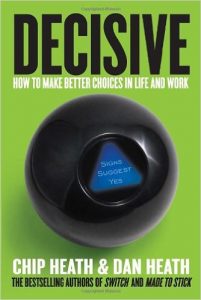This is part of an ongoing series of organizational and personal improvement book reviews. If you have read the book already use this as a reminder of key lessons. If you have not read the book and are looking to learn and grow as a leader, this summary will share the basics.
Decisive: How to Make Better Choices in Life and Work is a book by Chip and Dan Heath published in 2013. Lean East has previously reviewed their book Switch: How to Change Things When Change is Hard and also enjoyed Made to Stick.
is a book by Chip and Dan Heath published in 2013. Lean East has previously reviewed their book Switch: How to Change Things When Change is Hard and also enjoyed Made to Stick.
This book presents a fairly simple process for decision-making (click here for a one-page PDF of this process prepared by the authors). The content of the book focuses on the 4-step WRAP process and the end of the book also includes several case studies to learn from. I’ll summarize the WRAP process in simpler terms here.
The WRAP process has four parts, with each letter representing a simple phrase:
- Widen Your Options
- Reality-Test Your Assumptions
- Attain Distance Before Deciding
- Prepare to be Wrong
Much of the book looks at common decision-making biases we all fall victim to. Supplemental reading is recommended: see Thinking, Fast and Slow by Professor Daniel Kahneman and also check out our post on Influence: The Psychology of Persuasion by Robert Cialdini.
In a study of 1,048 business decisions over five years by McKinsey & Company researchers, it was discovered that “process mattered more than analysis – by a factor of six.” A good process led to better analysis while superb analysis proved useless unless the decision process gave it a fair hearing. Yet most of us rarely use a process for making decisions. Especially important decisions like changing careers, moving across the country, or getting married. Benjamin Franklin’s pros-and-cons list gets recommended most often, yet while better than nothing it has profound flaws. The WRAP process helps individuals and organizations avoid “the four villains of decision making” and arrive at better decisions.
The Four Villains of Decision Making
- Narrow framing (unduly limiting the options we consider)
- The confirmation bias (seeking out information that bolsters our beliefs)
- Short-term emotion (being swayed by emotions that will fade)
- Overconfidence (having too much faith in our projections)
The WRAP Process
Widen Your Options
The first step in the process involves reframing the decision. Don’t approach issues from an “either-or” or “whether or not” standpoint. Instead, uncover new options and consider them simultaneously. Push for “this AND that” rather than “this OR that” choices. Look around to find others who have made a similar decision and learn from them. Try laddering: First look for current bright spots (local), then best practices in the industry (regional) and then analogies from related domains (distant).
One simple example of reframing to widen your options is the decision to buy a $700 stereo or a $1,000 stereo with more features. Rather than the “either-or” choice, look at opportunity cost as well. Would you pay $300 for the extra features? What else could you do with the $300? What if you purchased $300 worth of your favorite music with that money instead? Another example is a decision on whether or not to fire an employee who is struggling on the job. Instead of the “fire-or-not” frame consider additional choices such as a development plan, different positions, change in responsibilities, etc.
Reality-Test Your Assumptions
In assessing options, the confirmation bias can lead us to collect skewed, self-serving information. To combat this bias, we can ask disconfirming questions. An example is playing the “devil’s advocate” role in a meeting and asking “What would have to be true for this option to be the very best choice?”
“Zoom out” and examine the base rates for a situation. When others made a similar choice, what was the typical outcome? Experts are often great at estimating base rates but lousy at making predictions of outcomes. Now “zoom in” to look at the specific details to seek more texture. And whenever possible you should “ooch,” or conduct a small experiment that will teach us more. For example, spend a week in a classroom teaching kids before you spend 4-6 years and $50,000 to $150,000 on your teaching degree. Why predict when you can know?
Attain Distance Before Deciding
Short-term emotion tempts us to make choices that are bad in the long term. To avoid that, we need to attain distance by shifting perspective: If my best friend had to make this decision what would I tell him or her to do? Or, if I am a leader of an organization, what would my successor do?
The authors also suggest a 10/10/10 analysis. To put your decision into perspective, ask how will you feel about this decision in 10 minutes? 10 months? 10 years? If you try this you will find many decisions that stress you out in the moment will likely be forgotten in 10 months, and certainly 10 years. Other decisions are simple to make but so important they should be tested first (see above).
“Agonizing decisions are often a sign of a conflict among your core priorities.”
By identifying and clarifying your core priorities it is easier to know how decisions will affect your values. Clarifying your values is unfortunately not the same as living your values. Once we establish our priorities we must go on the offensive for them against lesser priorities.
Prepare to be Wrong
Finally, when making your decision, know how to identify failure and have a plan for dealing with it. People tend to be overconfident, thinking we know how the future will unfold when we really don’t. We should prepare for bad outcomes (a pre-mortem is doing this in advance as part of the decision-making process) as well as good ones (a pre-parade is an advance plan of our celebration once we attain success.) Establish what success looks like and then bookend the future with a range of scenarios. In the pre-mortem ask “In a year from now – why did we fail?” And, “What would make us reconsider our decisions?”
Finally, we can set tripwires that snap us to attention at the right moments. Tripwires are used to warn us of an issue with our decision . . . hopefully before we continue further down a dangerous path. Partitioning can help us avoid “putting all of our eggs into one basket.” Deadlines can help get us unstuck when we are stuck on autopilot . . . “Six months ago you thought you’d have five customers by now and you have only one . . . does your business plan still work?”
We hope you enjoyed this summary of Decisive: How to Make Better Choices in Life and Work. The conclusion is that it is better to use a decision process than not. Try to review this Lean East post and use the WRAP process the next time you need to make an important decision. It can’t hurt, and may actually help quite a lot!
Original Flickr image above by Kristian Dela Cour



Related Posts
The God Complex: Why We’re All Making This One Mistake
How I am Changing the Career Advice I Give My Kids
This is Never Going to Work: Getting Lean Projects Unstuck